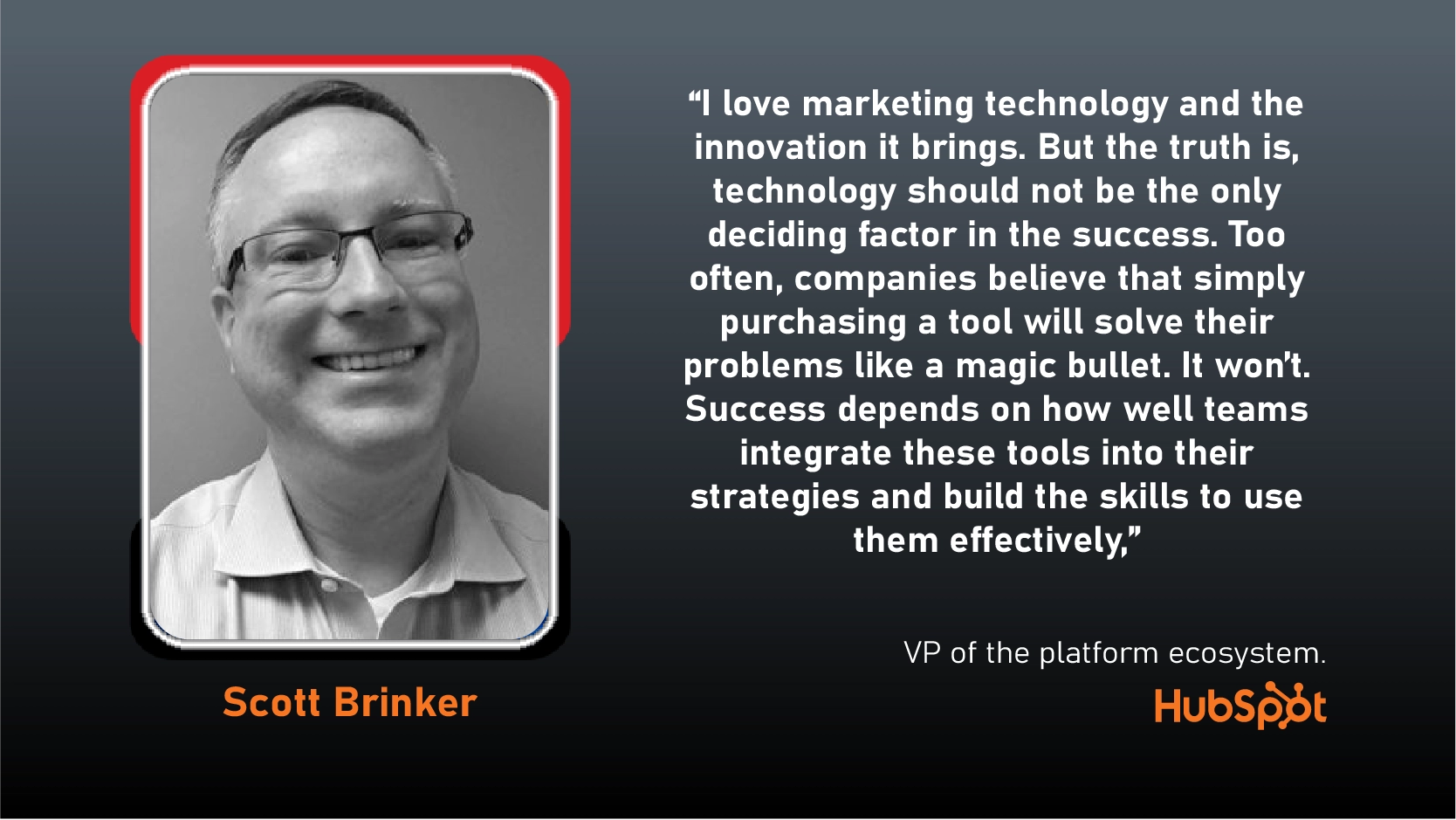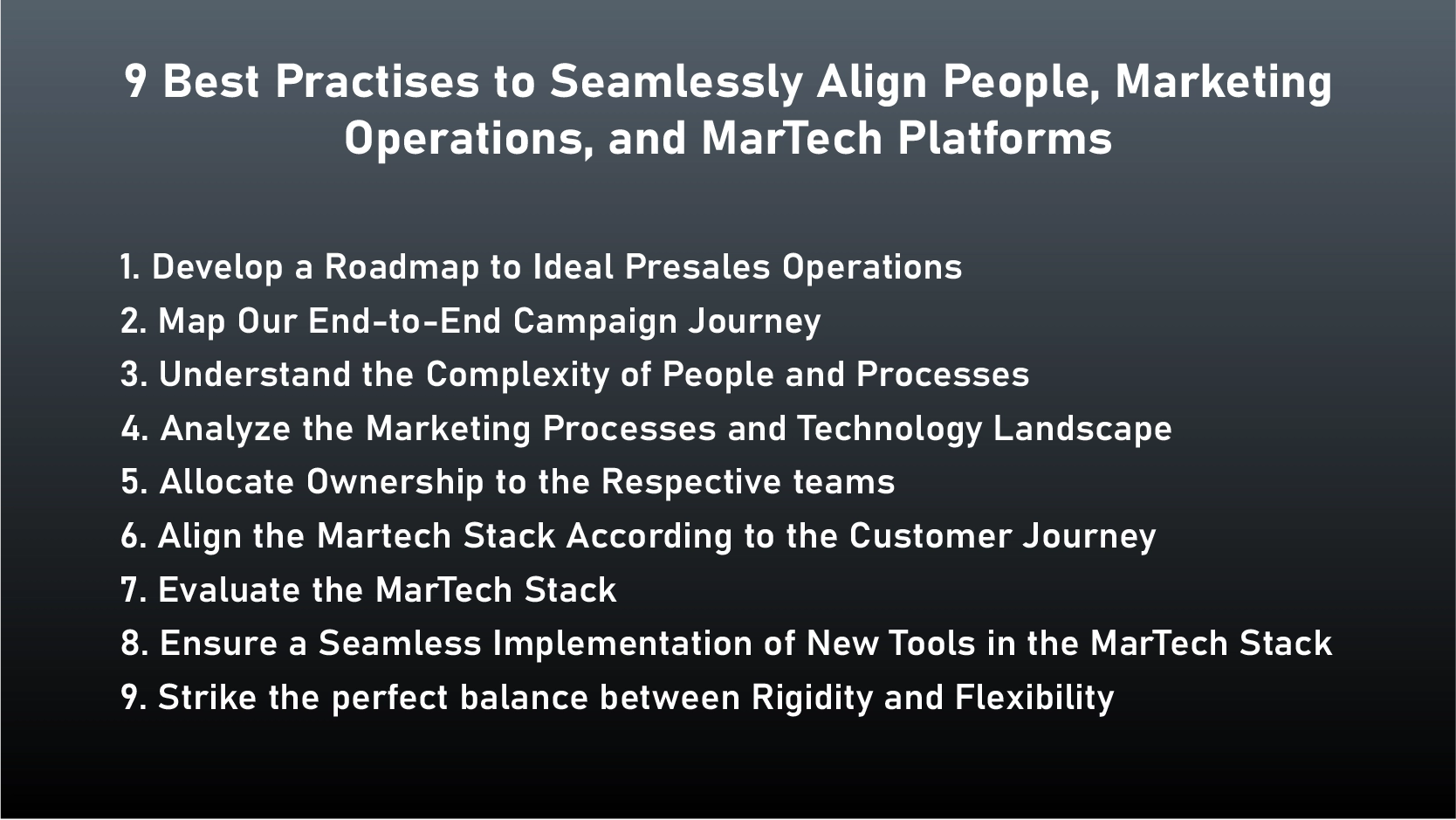The rapid surge in the number of marketing technologies and their applications can potentially blind the marketer’s perspective on establishing well-defined presales operations. According to the 2024 Marketing Technology Landscape Supergraphic, there are almost 14,106 marketing technology products, with a net addition of 3,068 products since the previous year, with almost 11,038 products in the market. The number of products added to the market witnessed 27.8% growth year-on-year.
Usually, tech vendors market their tools as quick fixes to all the marketing bottlenecks that the organization faces. In addition, they promise that their products will revolutionize marketing operations overnight. It might look alluring to a lot of decision-makers who are seeking opportunities to transform their work processes.

“I love marketing technology and the innovation it brings. But the truth is, technology should not be the only deciding factor in the success. Too often, companies believe that simply purchasing a tool will solve their problems like a magic bullet. It won’t. Success depends on how well teams integrate these tools into their strategies and build the skills to use them effectively,” says Scott Brinker, VP of the HubSpot platform ecosystem.
Watch Complete Podcast: MarTech360 Podcast with Scott Brinker, VP of platform ecosystem at HubSpot
One of the critical aspects that CMOs should consider is that implementing a new tool in the MarTech stack without addressing the underlying process bottlenecks can result in more problems than it resolves. Marketing leaders should focus on the need to overcome organizational and process inefficiencies while adopting new technologies.
Marketers who avoid redefining their processes before implementing a new tool are inviting challenges instead of overcoming the existing ones. Hence, it is important for organizations to have a seamless alignment between people, processes, and marketing technologies to improve the impact of their marketing efforts and have a higher ROI.
In this blog, let us have a look at the importance of aligning marketing processes with MarTech. We will also dive deeper into the best practices to align people, processes, and marketing technology stack to ensure success.
Also Read: AI in Omnichannel Marketing: What You Need to Know
The Importance of Aligning MarTech With Marketing Operations
Marketers are currently utilizing only 33% of their MarTech stack’s capabilities, according to Gartner’s 2023 report. Any new marketing technology platform is more likely to be underused when it is not seamlessly integrated with presales processes. Things will eventually get worse because the expense of the MarTech stack will continue to expand even when the utilization of these platforms decreases. It particularly is true in cases where stakeholders think that marketing technologies alone have the potential to resolve operational bottlenecks, irrespective of how efficiently they are in alignment with existing and future processes.
“The real hurdle is organizational. Many companies have grown with silos unintentionally. But now, the ability to connect marketing, sales, and operations with technology offers a chance to drive efficiency and improve customer experiences. The challenge isn’t the technology; it’s getting teams to work together and aligning the work processes according to the tools. Leadership must foster collaboration across departments, with cross-functional teams and hybrid roles, like the marketing technologist, which bridges the gap between IT and marketing. There’s no one-size-fits-all solution, but breaking down these silos is essential for leveraging the full power of modern martech,” adds Scott.
Organizations that aim for success should consider aligning marketing technologies with processes from the start. This approach enables decision-makers to determine the pain points that the new technologies will help alleviate and their impact on enhancing business processes.
Without a strategic approach, even if enterprises offer in-depth training to their users it restricts their potential to reap the full benefits of implementing a new tool. Because the users do not see a compelling reason to leverage the tool in the initial stages of implementation.
Enterprises should ensure that their MarTech stack is in alignment with the presales operations and prevent overlap among various integrated platforms. This approach will help marketing teams have enhanced productivity and time efficiency and significantly save costs.
However, it can be challenging for organizations to have a seamless alignment between work processes, people, and technology. Embracing the best practices is the key to ensuring a seamless transition.
9 Best Practises to Seamlessly Align People, Marketing Operations, and MarTech Platforms
 Businesses should consider analyzing their processes, workforce, and marketing tech landscape to make the most out of it. Here are a few practices that marketing leaders can consider to create a perfect alignment:
Businesses should consider analyzing their processes, workforce, and marketing tech landscape to make the most out of it. Here are a few practices that marketing leaders can consider to create a perfect alignment:
1. Develop a Roadmap to Ideal Presales Operations
In order to succeed in marketing operations, it is critical for the stakeholders to proactively develop a roadmap to have an ideal presales work process instead of waiting for a potential failure. Visualizing quick campaign planning processes and embracing people-driven approaches is an effective way to pave the way for efficient marketing operations. It is critical to align the organization’s vision of success with stakeholders’ objectives.
2. Map Our End-to-End Campaign Journey
Decision makers need to have a clear understanding of the current work processes utilized in presales operations. Stakeholders can cohesively work with their team and visualize their campaign journey to identify the inefficiencies and friction points in the marketing operations. Visualization of the end-to-end campaign journey will enable organizations to determine the areas that need improvement, automate repetitive tasks, and ensure streamlined interaction and collaboration throughout the teams.
3. Understand the Complexity of People and Processes
In comparison to the technologies, the people and processes are more unpredictable. However, people are at the heart of any successful process transformation. Organizations must change their mindset and work processes to ensure successful implementation.
Hence, defining technological needs in a request for proposal (RFP) will be a controlled exercise for enterprises to ensure success.
4. Analyze the Marketing Processes and Technology Landscape
Stakeholders should consider making a list of all the existing marketing platforms they have integrated into their tech stack. It is also important to make a list of all the new marketing platforms that your organization plans to integrate into its MarTech stack in the future. Once the list of all the marketing platforms is made, decision-makers should consider identifying the purpose of each platform.
5. Allocate Ownership to the Respective teams
Marketing leaders need to define which teams have ownership of which platform. There should be clear guidelines established to determine who is responsible for the maintenance of the platforms, who is responsible for offering training, and which team helps to set it up.
6. Align the Martech Stack According to the Customer Journey
Organizations must align marketing tools according to the customer journey to reap the benefits of integrated technologies. Decision makers need to understand how the buying funnel aligns with the MarTech stack. Defining which tool is used for the top, middle, or bottom of the funnel will help to streamline the process.
7. Evaluate the MarTech Stack
An in-depth analysis of the MarTech stack is an effective way to have a clear understanding of how people and processes are aligned with the integrated technology stack. Marketing leaders should evaluate all the tools on their tech stack to check if any of them overlap with other platforms. If any two tools overlap with one another, it is vital to check if they can be consolidated into one platform from a marketing perspective. If two tools are able to accomplish the same task, marketers can decide to eliminate one of them and save expenses.
8. Ensure a Seamless Implementation of New Tools in the MarTech Stack
Adapting to any new tools is one of the most important phases that should never be rushed. The implementation strategy should focus on determining the influence of technology on the current processes and people. Business leaders need to anticipate potential challenges and take necessary steps to streamline operations.
Before implementing any tool, businesses need to clearly communicate the value of the new technology and how it will help marketers streamline their operations. Also, one of the most effective ways to adopt any new technology is to set up a pilot team to check how it impacts the operations. Once the pilot team has successful results of implementation, the tool can be used by the other teams in the organization. This approach is proactive, which helps reduce the disruptions and makes way for a frictionless and successful transition.
9. Strike the perfect balance between Rigidity and Flexibility
It is essential to have structured presales operations. However, an extreme focus on rigid project management can hamper employee satisfaction and productivity. Enterprises should consider adopting agile and collaborative work ecosystems by enabling employees and processes to thrive.
Aligning People, Processes, and Technology for MarTech Success
Marketing leaders need to understand the complexity of aligning the workforce, operations, and technology. This approach helps decision makers to identify the bottlenecks in the operations and make necessary changes to overcome them. Marketing teams should align their technology investments with well-defined work operations to enhance their campaign efficiency and ROI. Organizations that have seamlessly aligned their people, processes, and technologies will be able to accomplish the desired goals.


Comments are closed.